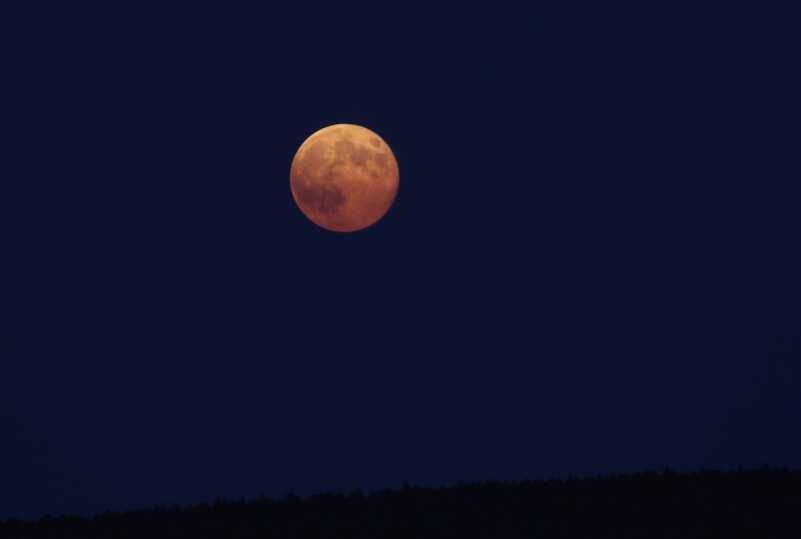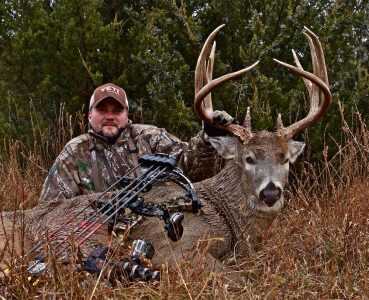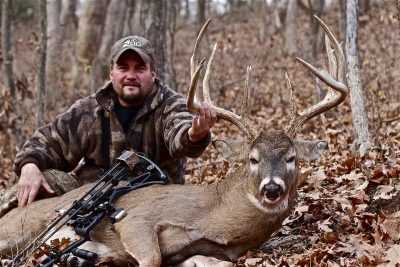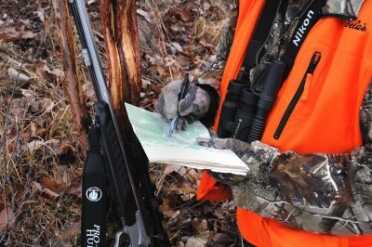
The moon has long been understood to influence the rise and fall of tides, but it may also influence the rise and fall of your success as a deer hunter. Image courtesy BLM.
For more information, visit https://www.moonguide.com.

Adam Hays has taken three 200-plus-inch bucks and a nice number of 170-inch and 180-inch whitetail bucks during his career. Image courtesy Adam Hayes.
SERIES
- Part 1: Top Four Tips To Scouting Now
- Part 2: Early Season Deer Stand Tips
- Part 3: Follow the Moon
- Part 4: Five Top Deer Gear Essentials
- Part 5: Five Top Backpacks
- Part 6: Essential Trail Camera Know-How
- Part 7: Making The Call
- Part 8: Keeping Warm
It is perhaps one of the more contested and hotly debated theories in all of deer hunting—does the moon actually influence whitetail movement and can a hunter benefit from knowing how? Ask Ohio hunter Adam Hays III what he thinks and you’ll get a confident, “Yes.” In fact, Hays plans his hunts around the moon’s position in relation to Earth and has the trophies to show for it—he has taken at least three 200-plus-inch bucks that he scouted and then hunted all on his own—one of only two recorded hunters to ever achieve the feat. He also has a number of trophies on his well that sport racks in the 170-inch and 180-inch range.
Like famed 1970s and 80s business owner and pitchman Victor Kiam, who was known from his commercials for Remington Shavers where he said he liked the product so much he bought the company, Hays believed in the late Jeff Murray’s Moon Guide so much, he now owns and sells the guide. The truth is, Hays and Murray were great friends, a bond built after Hays sought the older hunter out after finding success with his product. When Murray died from a lengthy illness at the age of 59, his family eventually approached Hays and asked him to carry on with the late hunter’s work. He has. And while Hays, one of the stars on the Team 200 television show, dedicated to teaching hunters how to find and hunt big bucks, continues to seek out more of his own big deer, he is busy helping other hunters understand how the Deer Hunter’s Moon Guide can help them find theirs as well.
Hays offers the following advice on using the moon for success throughout the entire deer season.
Early Season

Don’t ignore weather patterns, especially approaching fronts, which can kick deer movement into overdrive, particularly in the winter.
Early season deer can be among the most predictable to hunt as they are still unpressured and focused on food. But don’t think food is the only motivator behind deer activity. The moon is at work, too. Here’s Hays’ approach. First, scout religiously in the evenings, glassing agricultural fields and plots from a distance so you don’t impact the local herd’s behavior. Watch for big bucks—often still in bachelor groups now—moving into a particular open area. For real trophy bucks, Hays notes they won’t move far this time of year simply because they don’t need to; food and bedding are often close together. Nail down his habits and then consult the Moon Guide for those days they predict will be best.
Says Hays, “No matter what time of season it is, there are specific days each month that are much better than others…wait until that perfect day,” before making your move.
So what in the Moon Guide helps the hunter? Hays says there are only a few days each month where red moon times (red days he calls them) occur. Those are days when the moon is typically directly overhead or underfoot. Those days seem to influence deer movement the most. When overhead or underfoot times coincide with the times a deer normally feeds, your odds for success increase dramatically—provided you’ve done your homework and know where that big boy is hanging out.
[one_half]

When the moon is directly underfoot or overhead is believed to kick start deer movement leading to more deer seen and more deer taken.
[/one_half]
[one_half_last]

Most of Hays’ biggest deer have been taken right in his home state of Ohio, where he can put the most time into scouting and learning the land.
[/one_half_last]
The Rut and the Moon

During the rut, see when the moon will push deer to move during daylight hours and locate a good feeding location or bottleneck or travel corridor. Image courtesy of Bill Winke.
During the rut, when bucks are seemingly always on the move seeking out does, there doesn’t seem to be any rhyme nor reason to when and where you might intercept a monster. It could happen anywhere, anytime in big buck country. Even Hays once doubted the moon’s influence at this time of year, but after some experimenting with the Moon Guide to help him select stand locations and wound up killing two big bucks on different occasions, he’s changed his opinion.
“You can’t predict big buck movement at this time,” Hays says. “But the moon will affect when does are feeding; and when they are feeding, big bucks will be moving in search of them.” Hays tries to determine when optimal moon times will influence deer to feed during daytime hours and then selects a stand in a remote plot or in the deep woods. The rut may be on, but so is hunting season, and deer will feed, but often do so where there is cover of some sort if it’s daylight outside.
Late-Season Action

When moon times coincide with the last hour of sunlight, set up in a treestand on a remote field or food plot edge. Image courtesy of Bill Winke.
Late season, when the rut is over and deer have been hunted hard and food is scarce, can be when understanding—and trusting—the moon’s influence on whitetails can pay the biggest dividends.
“Food sources are more scarce, but you still need to key on them,” says Hays. He suggests identifying when the moon will influence movement right at dusk and set up on a field edge that hasn’t been hunted in at least a week or two.
“The moon at this time might be the only thing that encourages an otherwise nocturnal buck to move when it is still legal shooting time,” Hays says. Because deer may be moving from farther away to find food, a hunter may need to adjust his stand to sit farther back in the woods so he still has enough shooting light when the deer begin to move.
Oh, and as much as Hays believes in the moon’s influence, he admits rapidly changing weather patterns resulting in a sudden drop or rise in barometric pressure and temperatures, can play a bigger role in kick-starting deer movement than even that opaque orb circling the Earth. If you have a day when the moon’s overhead or underfoot position coincides with an incoming front, you could be in for an epic day of hunting Hays says. So, take advantage of all the info you can to maximized your success out on the hunt.
For more information, visit https://www.moonguide.com.

Sorry for the Solar tables thing.
I was talking about SOLUNAR tables, easily found and not that expensive.
Just look at moon tables for fishing. These do not fail. Look at when trophies are caught. There is the proof of timing the fishing with the hunt.
Whenever traveling through the countryside I see cows and horses eating, there is no doubt that fish and larger things are doing the same.
Follow the solar tables and you will not be disappointed.
Here is northern CA, the only issue that I’ve noticed where the moon plays a role is when it is full or near full at night. In my experience, the deer will move during the night to water and feed when the moon is well lit, instead of the morning or evening. It also results in possibly being seen when moving into position the 2-3 hours before dawn, as the deer may be moving. Due to extensive public hunting pressure, the best bet we’ve found is to hunt private land around food & water sources (e.g., orchards & ponds). With private land, the full moon tends to be less significant. I like these articles, but beginner hunters should check in with experienced hunters to avoid paying for new technical information to increase their odds. I’m in the middle between these two, and find talking to the old guys is well worth the time.
So how does this $25 paper wheel know what time zone you’re in?
Is it only for continental US or does it work in Alaska, Canada and Mexico? What about the the southern hemisphere?
Only for White Tail or does it work on Mule deer? What about Elk?
Killing a big deer requires finding an area where there are big deer. Same with catching a big bass.
I do believe there is a correlation as there research has indicated. Twenty five dollars for a one dollar paper wheel that is only useful for one season seems a bit steep, I will stick to Charles Alsheimer free rut predictions. I wonder how many thousands more of those wheels would sell at fifteen dollars. I have reloading manuals I consult year after year that cost less than twenty five dollars.